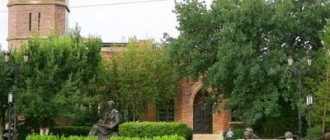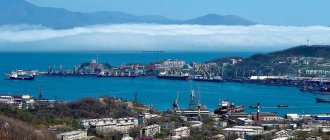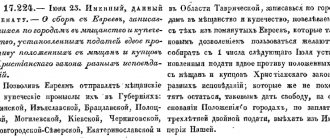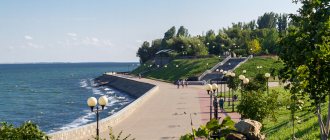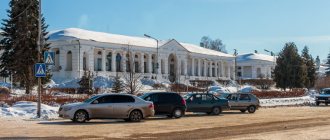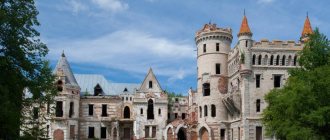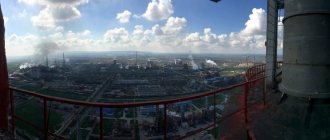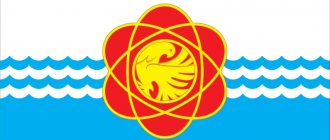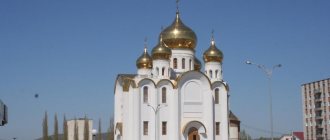| First day Second day Third day Alternative routes for day 3 Stories, routes and tips from tourists Where to stay in Volgograd Where to go from Volgograd for 3 days |
Volgograd is most often considered as a destination for a day trip or stops here on the way to other southern cities. However, it is worth staying here longer to feel the atmosphere of the hero city, almost completely rebuilt after the destruction of the Great Patriotic War. In addition to visiting the majestic monument “The Motherland is Calling!” and other war memorials, here you can get acquainted with the city's more ancient past.
Volgograd in 3 days is an opportunity to get to know the city not only as the site of the legendary Battle of Stalingrad. You will have time to walk along the streets that have preserved the appearance from the times when the city was called Tsaritsyn, visit the colony founded under Catherine II, and look at one of the largest hydroelectric power plants in Europe. Natural attractions in the vicinity of Volgograd are of interest; the journey to them will take from 3 hours, which is suitable for travelers staying here for several days.
Sculpture “The Motherland is Calling!” Photo: © Stanislav Kaznov
First day
It’s convenient to start exploring the historical center of Volgograd at Station Square, where the railway station is located. In front of it you will see the Barmaley fountain , made in 2013 in the image of a pre-war fountain. The composition with a round dance of children against the backdrop of destruction caused by air strikes appeared in a photograph from 1942 and made an indelible impression of the contrast of smiling children and the ruins of the city.
From the square, walk to several architectural monuments of pre-revolutionary times. On the street Gogol there is a red-brick mansion of the Repnikovs , which houses the Volgograd Memorial and Historical Museum with an exhibition about the Civil War. If you walk along Kommunisticheskaya Street, you will see the Tsaritsyn fire brigade building , restored according to the original of the 19th century.
Fire tower Photo: © Igor Butyrskii
Next, go to the Square of Fallen Fighters, past the monument to Alexander Nevsky and the New Experimental Theater in a building from the early 20th century. The Alexander Nevsky Cathedral , which was located on the Square of Fallen Fighters until it was blown up in the 1930s, is being rebuilt in the Alexander Garden It is worth walking along Volgodonskaya Street with several merchant houses of the late 19th century.
On the Square of Fallen Fighters you will see an obelisk to the defenders of Red Tsaritsyn near the grave of the Red Guards. Many people were also buried in the mass grave during the Great Patriotic War, and the Eternal Flame was lit in their memory. Not far from the grave of the Three Heroes there is a poplar tree that survived military battles. The green area with memorials is surrounded by post-war buildings. Don't be put off by Stalin's neoclassicism, in the style of which many buildings in the restored Stalingrad were built. The monumentality was intended to reflect the heroic and difficult times of the war. The central department store on the square was restored after the war and houses the Memory Museum . The exhibitions tell about the headquarters of the German commander F. Paulus located in the basement and his capture.
Details: Square of Fallen Fighters
In the Memory Museum Photo: © grau59
Along the Alley of Heroes you go to the central embankment named after the 62nd Army . First you will see the Art Fountain from 1957. Nearby there are two propylaea - structures with 8 columns, from which the central staircase . It connects the upper and lower tiers of the embankment. Steam shipping on the Volga actively developed at the beginning of the 19th century; many merchant ships stopped at the Tsaritsyn port, but the improvement of the area near the water began only at the beginning of the 20th century. Then a landslide practically destroyed the embankment, and the area along the river was redecorated again in the 1930s. After the war, restoration work began, which was completed by 1952. The staircase was built on the site of a military crossing; now during the holidays it is used as an amphitheater. There are various monuments on the embankment; pay attention to the Church of John the Baptist (2001), built on the site of the first stone church of Tsaritsyn.
In detail: embankment of the 62nd Army
Central staircase Photo: © Vasilina Babkovskaya
On the embankment there is the “Rodimtsev Wall” - a memorable place where Major General Rodimtsev’s division landed, which came to help in the battles for Stalingrad. Above it is the “Battle of Stalingrad” panorama museum with a large-scale painting about the defeat of the enemy at Stalingrad. In addition to the panorama, the museum’s halls display items related to the Battle of Stalingrad - personal belongings of the battle participants, photographs, weapons. Next to the futuristic museum building, the Gerhardt mill . This building was significantly damaged during the fighting, and its appearance continues to remind us of the destructive power of war. In front of the mill there is a second fountain, “Barmaley”, which against its background looks almost like a photo from the war years. It’s also worth going to Pavlov’s house , where our soldiers held the defense. The house was rebuilt after the battles, and a memorial wall was installed on it.
Details: Panorama Museum “Battle of Stalingrad”
Gerhardt's Mill Photo: © Maksim Starostin
What to see in Volgograd in 3 days? One of the “Seven Wonders of Russia” is Mamayev Kurgan . This is the main city attraction, consisting of a complex of objects “Heroes of the Battle of Stalingrad”. During the war, the height of the mound was called “Height 102.” Capturing and holding this height was of strategic importance for each side; it offered good visibility and shooting opportunities, so numerous heavy battles took place here. However, the feat of the defenders of Stalingrad made a turning point in the war. His memory is immortalized in a large-scale historical and memorial complex. The main object is the sculpture “The Motherland is Calling!” 85 m high. Together with it, the ensemble consists of several squares and sculptures, bas-reliefs, ruin walls, a memorial cemetery, and the Hall of Military Glory with the Eternal Flame.
More details: Mamayev Kurgan
Complex on Mamayev Kurgan Photo: © Vasilina Babkovskaya
You can get to Mamayev Kurgan by metrotram - this is a high-speed Volgograd tram, most of the stations of which are underground. Tourists recommend trips on the metrotram as one of the city's attractions. From Mamayev Kurgan you can go down to the Volgograd Arena stadium , built for the 2022 World Cup. For relaxation, you can stop in the central park of culture and recreation with attractions and a Ferris wheel.
Detailed advice on what to see in Volgograd in 1 day
Volgograd Arena Stadium Photo: © Sergey Makhinin
Notes
- UNESCO World Heritage Centre.
(English). whc.unesco.org. Retrieved March 17, 2016. - ↑
- ↑ Everything for you - Volgograd.
. Everything for you - Volgograd (July 16, 2013, 10:41). - Evgeny Volokitin.
. Vesti.ru (June 22, 2013 06:36). - Russia 1.
. News. Volgorad (21.06.2013 20:00 Video). - Kolesov Vladimir, Ershova Larisa.
Film “Pages of the Battle of Stalingrad” and its authors // St. Petersburg, “Alexander Sazanov Publishing House”: Russian ritual and spiritual magazine “Requiem”. - 2014. - No. 4 (105). - P. 4-14. - ↑ Arkady Uritsky.
(unavailable link). V1.ru (November 15, 2010). Retrieved November 18, 2010. - (unavailable link). news.vdv-s.ru (02/04/2008). Retrieved January 11, 2009.
- Rebrikova, Irina
(unavailable link). VOLGOGRAD.RU (02/29/2008). Retrieved April 10, 2008.
- (unavailable link). Retrieved July 22, 2008.
- ↑ V. Shanin, V. Agronsky 7 wonders of Russia and 42 more attractions that you need to know. - M.: Eksmo, 2011. - 224 p.
- Guinness Book of Records, 1988: translation from English / S. S. Fedotov, translator. - M.: Soviet Russia, 1989
- Elizaveta Listova. Motherland
(flv). strana.ru. Retrieved July 22, 2010.
Second day
Start your next day's walk by visiting the building of the Cossack Theater of the late 19th century. This is a red brick building with stucco, erected by the merchant Shlykov. Since the beginning of the last century, it housed a women's gymnasium, then other educational institutions; after the war, the restored building was given over to a cinema, and in the 1990s to a theater.
Details: Cossack Theater
Cossack Theater Photo: © Natalia Semchina
From the theater you can walk to the Kazan Cathedral . The church was consecrated in 1899; at the end of the 1930s it was closed and turned into a bakery. The building was damaged during the war, restoration was completed by 1948, and in the 1950s the church became a cathedral. The brick building was built in pseudo-Russian style; inside it is worth seeing the paintings made in the middle of the last century.
Details: Kazan Cathedral
Kazan Cathedral Photo: © Natalia Semchina
Next, take the train or buses to the Old Sarepta Museum-Reserve . This is a former colony of Germans from Gerngut, founded in the 18th century. The complex includes more than 20 buildings, dungeons and a museum of Russian mustard. In the museum you can get acquainted with the history of the Herrnhuters and their life in Sarepta, learn how they contributed to the development of the settlement and its transformation into a significant scientific and economic site.
Details: Museum-Reserve "Old Sarepta"
Museum-Reserve “Old Sarepta” Photo: © Catou
From the museum, go to the industrial achievement of the times of the USSR - the first lock of the Volga-Don Shipping Canal named after Lenin . Ideas about the need to build a canal connecting the Volga and Don were voiced several centuries ago, but work was carried out only by 1952. The entrance to the lock is decorated with a majestic arch 40 m high. On one side of the first lock, a monument to Lenin on the site of the Stalin monument, its height - 57 m. Between the monument and the lock there is a walking embankment of the Krasnoarmeysky district. On the other side of the entrance to the canal, a monument to the rivermen of the Volga Military Flotilla , serving as a lighthouse. Those interested in the details of the creation and operation of the canal can go to the Museum of the History of the Volga-Don Shipping Canal , located nearby.
Returning to the city center, you can again visit the embankment of the 62nd Army, go to the river station and take an hour-long walk along the Volga. From the river you will see the sights you have visited along the embankment in a new way, and will also pass under the Volgograd “dancing” bridge . When it gets dark, walk along the Alley of Heroes illuminated to imitate the starry sky. In the evening, you can attend a concert, performance or other cultural event in the Loft 1890 space. It is located in a historical building from the time of Tsaritsyn, this is the only surviving premises of the Zhiguli beer warehouses of the late 19th century.
Detailed advice on what to see in Volgograd in 2 days
Arch of the first lock of the Volga-Don Shipping Canal Photo: © Natalia Semchina
History of Mamaev-Kurgan
The monuments of Mamayev Kurgan in Volgograd occupied a special position in the military-patriotic history of the country, as well as the most important complex of memorials, which is dedicated to the events of the war. When the Battle of Stalingrad took place, Height 102 became a very significant and important object. This is due to the fact that the location of Mamaev Kurgan rose above the Volga and Trans-Volga regions.
This area became the grave for many people who gave their lives to protect Stalingrad and its surroundings. After the war ended, this land, under the yoke of bullets and shells, for a long time served as a landmark for all events and for all those who died for their land.
Thus, the idea came true to build a memorial to that very battle, and as a result, monuments were formed on the mound. This place in Volgograd is represented by a complex of memorial compositions, which were ultimately united by ideology and meaning.
Height 102 0 in Volgograd
Each complex of monuments provides a chance to see many pictures of the history of military events during the Second World War. The construction work lasted almost 8 years, during which time most of the sculptures and architectural monuments were changed, and certain solutions were created by engineers who were able to recreate unimaginable sculptures.
The third day
In three days, Volgograd will open up to you not only as a city with military history. After getting acquainted with the main memorials and visiting museums, you can travel outside the city.
Lake Baskunchak
Arriving in Volgograd for 3 days, tourists often go to see the salt lake Baskunchak (200 km from the city) in the neighboring Astrakhan region. Salt has been mined here for a long time, and now this place provides up to 80% of production in Russia. The area of the lake is 115 sq. km, a liter of water contains 300 g of salt. Rapa (water supersaturated with salt) and local mud are used for medicinal baths. The lake looks very unusual and impressive. It is part of the Bogdinsko-Baskunchaksky Nature Reserve ; it is worth looking at the lake by climbing Mount Bolshoye Bogdo . The mountain at its base is a salt dome covered with sandstone, limestone, and clay. It rises above Baskunchak by more than 150 m.
Details: Lake Baskunchak
Lake Baskunchak Photo: © mut-alya51
Volzhskaya hydroelectric power station and the city of Volzhsky
What to see in Volgograd in three days on your own? You can go to the largest hydroelectric power station in Europe - the Volzhskaya hydroelectric power station . The total length of the dam with the platform is more than 700 m. Many tourists are interested in seeing this powerful engineering structure. On the way from Volgograd to the hydroelectric power station, you can stop at the Lyudnikov Island memorial , created in memory of the events of the Great Patriotic War. The complex is located on the banks of the Volga and consists of mass graves, monuments and the ruins of a building - the headquarters of Lyudnikov’s division. This is not a real island, it is so named because during the war the enemy surrounded a Soviet division in this small area where heavy fighting took place.
If you drive through the hydroelectric dam to the opposite bank, you will come to observation platforms on the territory of Volzhsky . In this city it is worth taking a walk through the huge Gidrostroitel park , which is considered the only one in Russia that has preserved its original appearance. You can relax with children in the XXI Century water park . From Volzhsky it is convenient to get to the Volgo-Akhtubinskaya Poima natural park with various eco-routes. You can return to Volgograd via the Volgograd Bridge , which became famous in 2010 as the “dancing bridge”.
Volzhskaya HPP Photo: © Catou
Lotus Lake
If your trip falls in August, then it’s worth going to the Lotus Lake in the Volgograd region. It is during this period that the exotic plant blooms with beautiful pink flowers; in case of hot weather, flowering may begin earlier. The buds open in the morning and close in the afternoon, so plan your visit in the morning. You can drive there yourself (about half an hour by car) or take an excursion to the Volga-Akhtubinskaya Poima natural park.
The Volga-Akhtubinskaya Floodplain Natural Park is valuable for its landscape with a variety of water bodies and meadows. In spring and autumn, you can observe birds flying to and from wintering here. For tourists, various walking routes have been developed by bicycle, boat or on foot, for a couple of hours or for the whole day.
Details: Lotus Lake
Lotus Lake Photo: © Vladimir Zaruikin
Memorial Complex
The project for the future monument took a long time to develop. The all-Union competition, in which not only architects, artists and engineers participated, but also everyone who wanted to perpetuate the memory of those days, ended only 10 years later. J.V. Stalin personally chose the chief architect, E.V. Vuchetich, under whose leadership a group of sculptors, engineers and architects worked. Mamayev Kurgan in Volgograd is an architectural and structural composition that is united by semantic and ideological load. The total area of the memorial complex is more than 26 hectares, length - 1.5 km. Each sculptural group is isolated from the rest, but makes it possible to see the whole picture of the heroic and tragic events of 1942-43. The work lasted more than eight years, from 1959 to 1967, during this period many sculptural and architectural ideas changed, optimal engineering solutions were found, and more expressive sculptural forms were created.
Alternative routes for day 3
Volgograd in 3 days - a trip of this duration will allow you to visit places that are not the most obvious among tourists. You can choose leisure activities to suit every taste - walk through city museums, go to a remote military memorial complex, or go out into nature for the whole day.
Museums
In addition to the institutions mentioned above that are part of the Battle of Stalingrad Museum-Reserve (Mamaev Kurgan, Panorama Museum, Memorial Historical Museum, Memory), in Volgograd you can visit museums with other themes.
You can learn about the history and nature of the region at the Volgograd Museum of Local Lore . Its structure also includes:
- Museum of Musical Instruments E. N. Pushkin , created from the donated collection of instruments (242 pieces) by E. N. Pushkin. Now among more than 300 exhibits you can see stringed, pneumatic and other musical instruments; during the tour, visitors will hear the sound of some of the exhibits.
- Museum-apartment of M.K. Lukonin , a poet who lived in Stalingrad in his youth. The poet's personal belongings are collected here.
Art lovers should go to the I. I. Mashkov Museum of Fine Arts , where more than 9,000 exhibits are collected. The halls display Russian art of the 18th–21st centuries. (Bryullov, Tropinin, Shishkin, Polenov, Aivazovsky, Kuindzhi, Serov, Roerich, Goncharova), the work of Volgograd masters is highlighted separately. The collection of foreign art contains casts of ancient sculpture, oriental porcelain and woodcuts, paintings of the 17th-20th centuries, and there is a collection of works from the sister cities of Volgograd.
Museum of Russian Fairy Tales Photo: © Vera Polonskaya
An unusual collection is collected in the Museum of Weights and Measures at the weighing equipment plant. The exhibits date back to the 16th–20th centuries and tell the history of scales and the traditions of weight construction. The entertaining collection is popular with tourists with children. At a distance from the center there is the Museum of Russian Fairy Tales (Kirovets village) with thematic decorations, performances and games. The road from Volgograd to the Museum of Don Architecture and Life in the village of Ilovlya will take about an hour. In a picturesque place near the river you can walk around the territory with a traditional Cossack estate. Visitors will learn about Cossack culture, folklore and cuisine.
Those interested in space topics will enjoy the Volgograd Planetarium . The building itself in the late Stalin Empire style has an interesting history - it was erected on the initiative of the workers of the German Democratic Republic for the 70th anniversary of Stalin. The interior is decorated with expensive materials. The planetarium apparatus, assembled in Jena, is still in operation. From the porch of the building there is a panoramic view of Mira Street , which was the first to be built after the war in an almost completely destroyed city.
More details: museums of Volgograd
Volgograd Planetarium Photo: © Sergey Makhinin
War memorials
About 25 km from the city there is a memorial complex "Rossoshki" . This is a military cemetery where German, Soviet and Romanian soldiers are buried. During the Great Patriotic War there was a German cemetery here; other burials appeared after the opening of the memorial complex in the 1990s. Nearby there is a memorial sign on the site where there was a concentration camp for Soviet prisoners of war.
Soldier's Field will take about 15–20 minutes . This is another memorial complex where battles took place in the Battle of Stalingrad. After the war, the field was cleared and many shells were found. Now there is a mass grave here, monuments have been erected, and parts of the plows that were used to plow the cleared field have been preserved.
Memorial complex "Rossoshki" Photo: © Stanislav Kaznov
Natural parks
Natural parks in the vicinity of Volgograd are suitable for a relaxing holiday. Not far from the city there is the Donskoy Natural Park with chalk mountains and meadows. Several natural areas are located at a considerable distance (from 200 km), so you can go here for several days. "Shcherbakovsky" natural park is famous for the Stolbichi rocks and the picturesque landscapes of Volga Switzerland. The Tsimlyansk Sands Nature Park features a sandy landscape, rare species of animals and a herd of mustangs. In Nizhnekhoperskoye you can see the Shakinsky oak grove, the ancient Wild Field, Babinskoye Lake with floating islands, a sandy massif, and the Cossack village where M. Sholokhov lived.
160 km from Volgograd is the Shukshinsky cliff in the chalk mountains. Scenes of the film based on Sholokhov’s novel “They Fought for the Motherland” were filmed in this picturesque place. The writer, director and actor V. Shukshin died in a nearby village when filming was wrapping up. He loved to spend time on this cliff; a monument was erected here in memory of Shukshin.
Natural Park "Donskoy":
Monasteries
"Ust-Medveditsky" natural park is located on several rivers, the Don Cossacks lived here, and the Spaso-Preobrazhensky Monastery . Pilgrims strive to see the local shrine - a stone with the imprints of Abbess Arsenia (some say these are the footprints of the Virgin Mary). It will be interesting to look at the temple with 33 domes, built here in 2014.
The Kamenno-Brodsky Belogorsky Holy Trinity Monastery is famous for its surrounding nature - perennial oak trees, chalk mountains with ancient caves, healing springs.
From Volgograd it will take about 2.5 hours to get to the Akhtyrsky convent with a holy well. There is an opinion that Petrov-Vodkin painted his famous painting “The Bathing of the Red Horse” here, or rather its first version. It will take a little less time to get to the Kremensky Ascension Monastery , restored on the site of the monastery of 1693.
Review materials: Guide to Volgograd
Sights of Volgograd
Church of the Transfiguration in the Ust-Medveditsky Spaso-Preobrazhensky Monastery Photo: © Victor Martyanov
Battle for Mamayev Kurgan
There are many monuments on Volgograd soil that reflect the history of the Great War. One of them is located on the rise of Mamayev Kurgan. During the Stalingrad confrontation, they fought for Height 102 without sparing their lives.
It passed from defenders to aggressors and was necessary for both as a strategically important point in order to exercise control over the area. From the only hill it was possible to control the territory of the city and the Volga in the crossing area
The duration of the battle for the hill was 135 days, and the Battle of Stalingrad - 200. These battles claimed a lot of human lives and became the bloodiest in all four years of confrontation. As a result of the fighting, Hill 102 was recaptured, which was marked by the raising of the Soviet flag. After these battles, a turning point occurred in the entire course of the war, and the Soviet troops, having gained confidence, began to push the enemy to the borders of the state. An architectural masterpiece was erected in Stalingrad - the Motherland, which became a symbol of the great confrontation.
Thirty-four thousand defenders were buried in the land of Mamayev Kurgan. It was a place of weeping and mourning for the dead, as well as a symbol of unparalleled patriotism and soldier’s dedication. In 1959, a complex was erected on a hill, consisting of a number of individual sculptures, which became a symbol of victory and the memory of all those who died in this war.
Stories, routes and tourist tips
Volgograd in 3 days by the hour - stories from tourists will help you create such a program. In them you will find useful tips, walking routes and recommendations for exploring the city. Look at the reviews of tourists traveling around Russian cities by car with their families - they often stop in Volgograd along the way. From such reports you can get ideas for trips to neighboring cities and regions, since tourists usually spend 1-2 days in the city itself.
- Vladimir - story “May Day in Volgograd”
- Katerina - photo album “from the Volga to the Black Sea”
Natalia Semchina - a series of materials about holidays in Volgograd and the surrounding area of Lake Baskunchak:
- “Volgograd is a city of blooming lilacs. Mamaev kurgan";
- “Tsaritsyn-Stalingrad-Volgograd. Start of the walk";
- “Tsaritsyn-Stalingrad-Volgograd. The city is a symbol";
- “Picturesque Lake Baskunchak”;
- “Lower Baskunchak, what else is interesting here besides the lake”
Read all tourist reviews about Volgograd
Volgograd Bridge Photo: © Maksim Starostin
Sightseeing tours
If you find it difficult to choose what you can see in Volgograd in one day or want a deep immersion in the history of the city, then you should turn to professional guides. A sightseeing tour of the city usually takes 3–4 hours and offers a rich program with travel by car or on foot. Walking tours of the sights of Volgograd in 1 day include the most important city places and memorials, as part of the tour you will also learn about the life of Volgograd in different eras. The guides will take you not only to restored and new sights, but will also show you houses that survived the revolution and war.
City tours in Volgograd
Pavlov's House Photo: © Magdalena happiness
Where to stay in Volgograd
If you want to get acquainted with the sights of the city, monuments of military history and museums telling about them, you should consider housing options in the vicinity of the beginning of Lenin Street. It is there that the Battle of Stalingrad Museum, the Central Staircase to the 62nd Army Embankment and the ruins of the Gerhardt Mill are located. There are several hotels here, the rest are located higher up, behind the railway line. There are more offers for apartments, almost all of which, thanks to good competition, maintain a decent level of hospitality and service.
When deciding to explore housing in other areas, keep in mind that Volgograd is one of the longest cities in Russia. Pay close attention to the location and transport accessibility. An interesting option for the summer are park hotels and bases on the Krasnoslobodsk side near the spacious sandy beaches on the Volga. The famous Dancing Bridge leads there, and it’s very close to interesting places.
- Volgograd Hotels
- Hostels for Budget Travelers
- Flats and apartments
When choosing accommodation on Booking.com, do not forget about the opportunity to get cashback: Cashback promotion for Tourist. RU
Arch of the first lock of the Volga-Don Shipping Canal Photo: © Alexander Smirnov
Volgograd river port
This is the main port on the Volga, from where ships and river cruises depart. The territory of the river port is approximately the same as Red Square in Moscow. Where to go in Moscow The main decoration of the architectural complex is the observation deck, which locals call the “puck”
Hall of Military Glory and lists of those killed on Mamayev Kurgan.
Heroes Square abuts the retaining wall of the mound, decorated with bas-reliefs, the theme of which is the victory of the Soviet people over fascism. Through an entrance made in the wall, visitors enter the Hall of Military Glory, which serves as a temple of sorrow for the defenders of the city of Stalingrad who died in a fierce battle. In the center of the structure, made in the form of a cylinder, a marble hand rises from the floor, holding an ever-flaming torch. This symbolizes the help of fallen soldiers in the fight for the cloudless future of the Motherland. On the walls of this pantheon there are slabs framed with mourning ribbons, on which are inscribed the names of soldiers and officers who died in the battles for the liberation and defense of the city. The mournful feeling is enhanced by the sound of a steadily beating heart and the quiet performance of Schumann’s “Dreams”. At the exit from the hall and near the blazing eternal flame, as a tribute to the descendants of the dead, there is a guard of honor, changing every hour.
"Fight to the Death" Square
The granite staircase ends the alley of poplars. It ends with a platform with a swimming pool in which the sculpture “War” is located. The hero with a machine gun in his hand is made of a monolithic block of stone. This composition personifies the most difficult period of the Battle of Stalingrad, when the courage of the Soviet soldier broke the enemy’s confidence in his invincibility. Under a hail of bullets and shells, people who despised death and looked it in the face attacked the enemy. The warrior rises from his native land. She serves him as a reliable support in the most terrible hour of battle. The territory of the "Fight to the Death" square ends with a staircase consisting of 200 steps - this is the number of days and nights of the battle for Stalingrad.
